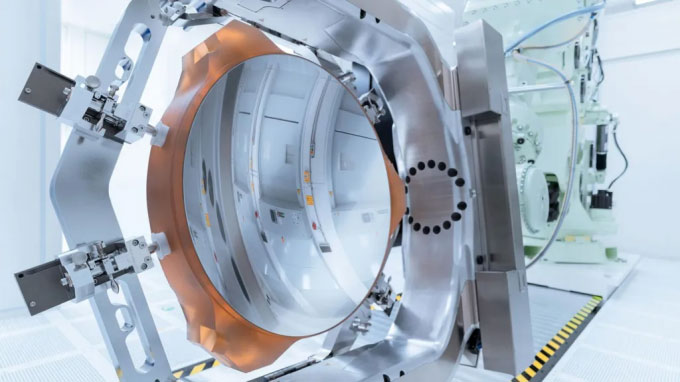The world's most advanced mirrors
Mirror of the world's largest optical telescope
The world's largest optical telescope, the Extremely Large Telescope (ELT), is being built on a mountain high in the arid Atacama Desert in Chile by the European Southern Observatory (ESO). By 2028, the ELT is expected to begin collecting images and help expand humanity's understanding of the universe.
The ELT has five giant mirrors, M1, M2, M3, M4, and M5, which collect and guide light to the telescope's measuring instruments. The primary mirror, M1, is the largest mirror ever built for an optical telescope, measuring 39 meters in diameter and made up of 798 hexagonal mirrors, aligned to act as a perfect monolithic mirror. M1 can collect 100 million times more light than the human eye, maintaining its position and shape with 10,000 times the precision of a human hair.
The M2 convex mirror is 4.25m in diameter. The M4 is capable of changing shape 1,000 times per second to adjust for atmospheric turbulence and telescope vibrations - factors that can distort images - and is the mirror with the largest deformable surface in history.
The world's lightest quantum mirror
In 2020, scientists at the Max Planck Institute for Quantum Optics successfully developed a quantum mirror consisting of 200 aligned atoms that work together to reflect light, creating a mirror so small it is invisible to the naked eye.
In 2023, they successfully placed a microscopically controlled atom at the center of a mirror, creating a "quantum switch" that controls whether the atom is transparent or reflective, opening up potential applications in a variety of quantum technologies, such as hack-proof quantum networks for storing and transmitting information.

Super flat mirror
In Oberkochen, Germany, the optics company Zeiss is making ultra-flat mirrors that are becoming a key component in computer chip printers called extreme ultraviolet (EUV) lithography machines.
Zeiss' EUV mirrors can reflect light at very small wavelengths, allowing images to be seen at extremely small scales, allowing more transistors to be printed on the same area of silicon wafer.

Dr. Frank Rohmund, president of Zeiss's semiconductor optics division, uses a topographical analogy to explain how flat these mirrors are. If a household mirror were enlarged to the size of Germany, its highest point would be 5 meters, while on the James Webb Space Telescope's mirror it would be 2 centimeters, and on an EUV mirror it would be just 0.1 millimeters.
The ultra-smooth mirror surface combined with mirror position control systems provides extremely high precision.
You should read it
- The 5 largest aircraft in the world are dominating the skies
- Top 100 largest websites in the world
- The world's largest aircraft model completes its first journey
- 'Castle in the sky' - the world's largest aircraft is about to launch
- The world's largest aircraft reaches an altitude of nearly 1,200 m
- Smart mirrors integrate computer touch screens like in science fiction movies
- Deciphering the mystery behind Louis Alvarez 1743 'killer' mirror kills 38 people
- The world's largest dark web is down
May be interested
- How to enable advanced settings on Windows 11
 microsoft introduces redesigned advanced settings page in windows 11, adding system customization for developers and advanced users with new features
microsoft introduces redesigned advanced settings page in windows 11, adding system customization for developers and advanced users with new features - Advanced Subnet Calculator - Download Advanced Subnet Calculator here.
 advanced subnet calculator is a program that helps ensure that your ip addresses do not conflict with each other and saves time managing dhcp, dns and ip addresses.
advanced subnet calculator is a program that helps ensure that your ip addresses do not conflict with each other and saves time managing dhcp, dns and ip addresses. - Link Download Advanced English Dictionary 4.1.0.1
 advanced english dictionary is a new way to discover the meaning of unknown words. with over 4.9 million words, phrases and definitions, including countless new words, sample sentences and usage notes, advanced english dictionary makes finding the exact meaning of a word easier than ever. .
advanced english dictionary is a new way to discover the meaning of unknown words. with over 4.9 million words, phrases and definitions, including countless new words, sample sentences and usage notes, advanced english dictionary makes finding the exact meaning of a word easier than ever. . - How to enable Google Advanced Protection
 google's new advanced protection feature is coming to pixel devices and android 16. it's google's strongest security feature yet, designed to stop malware, phishing, or theft.
google's new advanced protection feature is coming to pixel devices and android 16. it's google's strongest security feature yet, designed to stop malware, phishing, or theft. - The 'mirror super power plant' from 12,000 giant mirrors produces electricity even at night
 the solar power plant located in dunhuang, northwest china's gansu province uses concentrated solar energy through mirrors and molten salt technology to produce electricity at night.
the solar power plant located in dunhuang, northwest china's gansu province uses concentrated solar energy through mirrors and molten salt technology to produce electricity at night. - How to change advanced settings hidden in the browser
 the browser has many settings, the option is hidden. each browser has a place where you can change many advanced settings, not in your standard options window.
the browser has many settings, the option is hidden. each browser has a place where you can change many advanced settings, not in your standard options window. - How to use WhatsApp's new advanced search feature
 recently, the whatsapp messaging platform has added dark mode. however, there is another quite convenient feature that users do not know. it is advanced search (advanced search).
recently, the whatsapp messaging platform has added dark mode. however, there is another quite convenient feature that users do not know. it is advanced search (advanced search). - 6 months copyright reader IObit Advanced SystemCare PRO 12
 tipsmake.com will give you 6 free copyright months of iobit advanced systemcare pro 12. please scroll down to the end of the article to get your advanced systemcare pro 12 key.
tipsmake.com will give you 6 free copyright months of iobit advanced systemcare pro 12. please scroll down to the end of the article to get your advanced systemcare pro 12 key. - How to install Advanced SystemCare Pro, error repair software for Windows 10, 8, 7, Vista, XP
 installing advanced systemcare pro helps fix errors and speed up windows 10, 8, 7, vista and windows xp. the computer will operate faster with advanced systemcare pro, especially for gamers, using advanced systemcare pro helps with better internet connection and smoother game play.
installing advanced systemcare pro helps fix errors and speed up windows 10, 8, 7, vista and windows xp. the computer will operate faster with advanced systemcare pro, especially for gamers, using advanced systemcare pro helps with better internet connection and smoother game play. - What to do for 1.5TB RAM on Apple's most advanced Mac Pro?
 the most advanced mac pro version has up to 1.5tb of ram. the capacity is too large to make many people wonder, what is the amount of ram used when 10 chrome tabs only occupy 1gb of ram?
the most advanced mac pro version has up to 1.5tb of ram. the capacity is too large to make many people wonder, what is the amount of ram used when 10 chrome tabs only occupy 1gb of ram?










 Captured electrons moving at 7,920,000 km/h
Captured electrons moving at 7,920,000 km/h Is it good to eat guava, including the skin?
Is it good to eat guava, including the skin? The world's 'stupid' bird, at the moment of life and death it 'loses its memory'
The world's 'stupid' bird, at the moment of life and death it 'loses its memory' 10 strangest military vehicles in world history
10 strangest military vehicles in world history What happens when lightning strikes a lake?
What happens when lightning strikes a lake? Fabric that cools the body up to 8 degrees Celsius
Fabric that cools the body up to 8 degrees Celsius